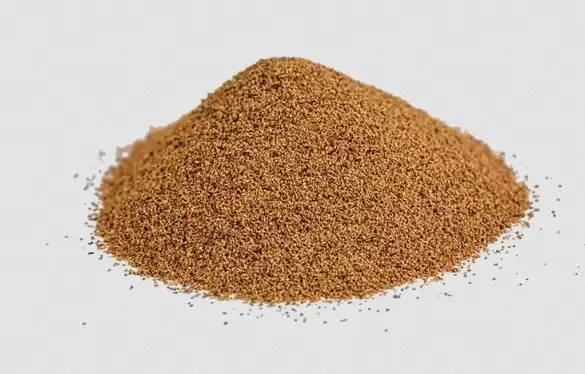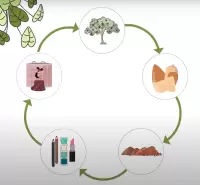Exploring Benefits of Upcycled Material in Corporate Sustainability
Embracing the Eco-friendly Role of Upcycled Material
The emerging industry of upcycled material offers immense potential for firms seeking to decrease their environmental footprint while staying committed to their business goals. For many, the term 'upcycled material' might still be a novel concept. In essence, upcycling involves the transformation of waste products, discarded items or even secondary materials into new items of better quality or greater environmental value.
Companies exploring the realm of upcycled material will find a vast array of options suitable to their varying needs. For instance, a fashion retailer might turn to discarded fabrics and plastics to create an innovative and new line. The resulting products, well beyond being trendy and unique, are also mindful of the environment and might attract the growing market of environmentally conscious customers.
Manufacturing businesses have a dual opportunity. They can even incorporate upcycled material into their core functioning, leading to both cost and waste reductions. For example, the utilization of upcycled metals in creating machinery components. Or perhaps, they may choose to reduce industrial waste, averting it from landfill and reducing the overall carbon footprint. This opens a gateway to a generation of green jobs, leading to a boost in corporate reputation amongst engaged stakeholders.
However, it is important to respect the integrity of the upcycled material. Companies need to ensure the sourcing process is ethically sound, the material quality is satisfactory, and the manufacturing methods used boost rather than devalue the material's eco-credentials.
Furthermore, upcycled material present an opportunity for businesses across the spectrum. From the creation of artistic pieces and furnishings to high-end products like upcycled wood flooring, these materials offer diverse solutions that can align with a company's eco-initiatives whilst maintaining design aesthetics and quality.
Ultimately, the journey towards sustainable business practices entails various approaches. Integrating upcycled material into regular operations or product lines significantly contributes to this goal. While stimulating creative innovation and problem-solving, it sends a powerful green message, enabling firms to reach their sustainable objectives, propel market differentiation, and establish a competitive advantage.
Distinguishing Upcycling from Recycling: Key Differences and Similarities
With sustainability concepts gaining traction, the nuances between upcycling and recycling become more pertinent. At first glance, both practices sit under the umbrella of waste management and resource optimization. Yet, below the surface, important distinctions separate them, reflected in the end products of upcycled material versus recycled material.
- In recycling, waste materials are converted back into raw materials, followed by reprocessing into new items. Take the example of paper recycling that involves the breakdown of used paper into pulp and reconstitution into fresh paper. On the downside, each recycling cycle weakens the material quality, limiting the number of feasible recycling rounds.
- On the other hand, upcycling adds value to discarded items, converting them into products of higher worth in comparison to their original form, without necessarily altering their chemical structure. This process decreases landfill targets and reduces the necessity to extract virgin raw materials. XinChen hardware, for example, upcycles scrap metal from the production process into industrial-style lamps.
Understanding these subtle differences prompts enlightened choices towards environmental stewardship. Incorporating upcycled materials into the business model allows companies to promote sustainability without necessarily sacrificing quality. Firms focused on eco-consciousness might integrate upcycled materials into their operations, encouraging green practices, and addressing the 'waste concerns' of their customers, partners, and stakeholders.
Companies can learn from observed practices among peers and competitors alike, identifying key upcycling techniques applicable in their sector. Expanding the usage of upcycled material is likely to generate a positive corporate image while possibly mitigating costs associated with fresh resource acquisition.
Similarities between recycling and upcycling include the obvious focus on waste reduction, environmental sustainability, and conservational resource utilization. However, upcycling stands out for being less energy-intensive, adding more value to waste materials, and minimizing quality degradation.
To summarize, businesses keen on sustainability, workforce safety, and environmental compliance may find upcycling strategies to align with their sustainable material agendas, in ways that recycling can’t match, especially with regard to value addition to waste. The incorporation and improvement of upcycled materials can result in unique, resource-efficient, and high-value end products.
Materials Ideal for Upcycling and their Sources
When considering the utilization of upcycled material, there are certain materials that prove to be more versatile and readily available for this purpose. Five of these are wood pallets, glass bottles, old metal, discarded fabrics, and used paper.
- Wood pallets emerge as a consistent favorite in the world of upcycling, with businesses generating an abundant supply. Often considered waste, these resources provide an ideal medium for creating custom-designed furniture, wall art, or events deconstructed for use in various woodworking projects.
- Glass bottles are another readily available material ideal for upcycling. Usually destined for the recycling bin or worse, landfills, these containers can be transformed into luminaries, vases, or even serving platters. The sources for these could be eateries, breweries or even households, all which are known to discard glass bottles after use.
- Old metal, an often discarded material, opens up an array of possibilities for upcycling. Sourced from vehicles, appliances, and other industrial waste, smaller metal parts can be combined to create intricate sculptures or used for garden embellishments. It's recommended that businesses in the automotive and electronics industries could be approached to source this material.
- Even fabric, typically seen as non-recyclable, can become a versatile upcycled material. Old clothes, curtains, or sheets can be converted into bags, pillows, or even rugs. Sources of discarded fabric could include fashion and textile companies or charity shops; the list is endless and largely untapped.
- Lastly, used paper, typically viewed as a single-use item, can be subjected to upcycling. Paper from magazines, newspapers, or packaging can become notebooks, envelopes, or wall decor. Business offices, retail establishments, or print media agencies can be potential sources for used paper.
By focusing on these five materials, sustainable practices can be combined with inventive creativity, bringing in unforeseen opportunities for businesses. These resources are not only easy to obtain but provide a wide range of application possibilities for upcycle design. Understanding this potential, businesses have the opportunity to reduce their ecological footprint, cater to a market invested in sustainability, and convert what was once waste into objects of value.
Companies Successfully Harnessing the Potential of Upcycled Material
Ethical companies worldwide are steadfastly embracing the practice of using upcycled material in their merchandise, displaying innovation and dedication to the environment. Recognizing the potential of these materials not only benefits the planet, but also creates unique, high-quality and/or upcycle design products that appeal to an environmentally conscious market.
Take, for instance, Patagonia, a renowned outdoor clothing company, which has incorporated recycled polyester into their products since 1993. They have taken the idea of upcycling to the next level through their “Worn Wear” program that repairs and recycles old Patagonia gear.
Another business in the footwear industry, Rothy’s, stands out for its utilization of upcycled material. The shoes, composed almost entirely of recycled plastic water bottles, have a unique appeal among consumers for tangible sustainability with style.
Terracycle, a waste management company, has truly harnessed the potential of upcycled material across a variety of sectors. They specialize in recycling hard-to-recycle waste and have partnered with consumer product companies to create unique upcycled products.
Parley for the Oceans is a notable example of the sports industry. Partnered with Adidas, they combat marine plastic pollution by creating upcycled ocean plastic products, effectively turning a global problem into sleek, marketable solutions.
In the home decor and upcycle design sector, Pentatonic stands apart, offering furniture and accessories created from a variety of upcycled material, including glass, electronics, food, and even cigarette butts. They focus on developing products that are not only environmentally friendly but also high-end and appealing.
Lastly, BioPowder.com specializes in by-product upcycling or circular economy upcycling. The company produces high-performance powders from premium olive stones, an upcycled by-product of olive oil production, which find various applications across industries. Olive stones are part of the solid residue from the oil mill, i.e. they are part of the pressing cake consisting of pulp, shell and crushed stones. With the help of specialized machines, those stone fragments are separated, cleaned and dried. The result is a stable, light-beige grain that can be further processed into micro-powders and granules.
Besides olive oil residues, BioPowder also upcycles the side streams (by product) of fruit processors, such as almond shells, pistachio shells, peach stones or apricot stones. The logic is similar: BioPowder collects the raw material at the source, screens and dries it, and ensures that it is suitable for further transformation into powdery bio-ingredients.
BioPowder caters predominantly to businesses seeking innovative, sustainable solutions. The upcycled material can be effectively used across a diverse range of sectors, including cosmetics, coatings, construction, automotive, and packaging industries. By integrating this upcycled material into their supply chains, firms can significantly improve their environmental footprint.
Proven to be a pioneering choice for enterprises, BioPowder displays exceptional versatility. Its unique production process results in fine or coarse grain options, offering companies the freedom to select the perfect texture for their unique purposes. Be it as an abrasive, a filler, or a surface coating texturizer, BioPowder aligns impeccably with varied industrial applications, promising improved performance.
At BioPowder.com, our commitment is consistent: spearheading upcycled material innovation while delivering superior quality, sustainability, and cost-efficiency. The nature of repurposing agricultural by-products means that the supply is ample and consistent, ensuring customers can maintain stable, disruption-free supply chains that strive for environmental sustainability.
The procurement of our base material is executed in full compliance with fair trade and ethical business practices, thus catering to firms that prioritize corporate social responsibility. Additionally, seeking BioPowder's upcycled material provides businesses with an effective means of demonstrating their commitment to sustainable practices.
As an industry vanguard in upcycled materials, BioPowder's innovation also covers end product development and comprehensive support to customers R&D. Formulation and testing assistance helps them understand the superior benefits of using powders made from upcycled material, while guiding them through a seamless transition process, hence enabling the reduction of their ecological footprints and boosting their green credentials.
Watch the video to learn more:
Each of these companies highlights the power of upcycled material in addressing environmental issues while meeting consumers’ needs. Harnessing the potential of upcycled material, they inspire others in the market to consider this rewarding, sustainable business path.
The Environmental Impact of (By-Product) Upcycling
The environmental benefits of upcycling are increasingly recognized by businesses, especially those keen on sustainability and eco-efficiency. Through the use of upcycled material, companies can play a crucial role in waste reduction, resource conservation, and even greenhouse gas emission reduction.
Upcycled material can significantly reduce waste by converting unwanted products into valuable resources. By giving a second life to products that were destined for landfill, businesses help lower the amount of waste that ends up in landfills, thereby reducing methane emissions, a potent greenhouse gas. Additionally, upcycling diminishes the need for extracting more raw materials, which significantly minimizes soil degradation and potential water pollution resulting from the extraction process.
Air and water pollution can also be lessened as upcycling decreases the demand for new goods production. The manufacturing of new items often involves using considerable energy and releasing harmful substances into the environment. Utilizing upcycled material to create new products requires a small fraction of that energy and releases minimal pollutants.
Upcycling is a powerful tool for carbon footprint reduction. According to the United States Environmental Protection Agency, recycling can save over 1.5 tons of carbon dioxide per ton of aluminum and almost a ton per ton of mixed paper. The carbon-saving potential of upcycling is likely to be even higher, considering that it often involves minimal processing compared to traditional recycling.
Furthermore, upcycling has ripple effects on a wider scale. It shifts the consumer mindset from a throwaway culture to a circular economy and resonates with environmentally conscious consumers. When businesses integrate upcycled materials into their products, they send a potent message to consumers about their commitment to sustainability.
To optimize the environmental benefits of upcycling, companies should minimize the energy used in their upcycling processes. They can employ energy-efficient technologies and strive for operational efficiency. Additionally, they should source upcycled material locally whenever possible to reduce transport emissions.
Practical Steps to Integrate Upcycling into Your Business Model
Incorporating upcycled materials into a business model requires a strategic approach. Here are eight practical steps to seamlessly integrate upcycled material utilization into your business operations.
- Thoroughly research the Market: Understanding the preferences and tendencies of your target audience is vital. It is recommended to conduct market research to understand the demand for upcycled material within the targeted industry. This research could provide valuable input on product development and market positioning.
- Source viable upcycled materials: Identification and selection of reliable sources for upcycled material are crucial. This process could include building partnerships with waste management companies or sourcing directly from consumers.
- Analyze material suitability: Not all materials are suitable for every purpose. Evaluating the feasibility of using specific upcycled materials in your products or services should precede their integration.
- Utilize green design concepts: Green design principles can help incorporate upcycled materials. These principles focus on minimizing waste and optimizing resources, which aligns well with the goals of upcycle design.
- Implement cost analysis: Consider the financial implications of including upcycled material in your production process. Analyze the cost-efficiency of your sourcing, processing and distribution methods to ensure financial sustainability.
- Adjust your quality management: As with any material, upcycled resources must meet your quality standards, which might need to be adjusted to new materials. Establishing regular quality control checks ensures consistency and reliability in your final products.
- Define clear marketing strategies: Companies need to communicate their upcycling initiatives to customers effectively. Credible marketing strategies can emphasize your commitment to sustainability, potentially attracting environmentally conscious consumers.
- Continual upgrades and innovation: The market for upcycled material-based products evolves rapidly. To stay competitive, regular product and process innovation should be integral.
By adhering to these steps, enterprises can effectively integrate upcycled materials into their existing business models. Fine-tuning of each step to align with specific business realities can further enhance the integration process.
Navigating the Challenges and Potential Solutions in Upcycling
While reusing and repurposing typically discarded materials is at the core of upcycling, companies may encounter challenges that could impede the implementation of this sustainable practice. By identifying these obstacles, it's possible to devise appropriate solutions to overcome them.
One of the challenges businesses might encounter is sourcing upcycled material. The availability and accessibility of such materials might be inconsistent, which can disrupt the supply chain. Potential solutions can include establishing partnerships with suppliers prioritizing waste collection, or creating local networks for waste disposal and upcycling.
Quality control poses another challenge when it comes to upcycling. The original quality and condition of reclaimed materials significantly affect the function and durability of the upcycled products. Industrial entities can introduce systematic sorting methods to separate unusable materials from suitable ones, or develop cleaning and repair protocols to enhance material quality.
Another potential challenge is perceived product value. Upcycled materials, being salvaged from waste, might be seen as inferior or less appealing. To address this, companies can use robust marketing strategies to emphasize the concept of transformation, environmental responsibility, and exclusive, unique upcycle design concepts inherent in the upcycling process.
Compliance with industry standards and regulations can be a particularly challenging aspect. Upcycled materials, due to their diverse origin, may not always meet stringent manufacturing regulations. By advocating for more inclusive standards and demonstrating the safety and effectiveness of upcycled products, companies can pave the way for wider acceptance of upcycled materials.
Engaging in upcycling practices inevitably involves additional costs. However, these could be mitigated by incorporating cost-efficient processes, optimizing the use of available resources, and aligning circular economy strategies with business objectives.
To conclude, despite the challenges that enterprises might encounter, several solutions exist to facilitate the incorporation of upcycled materials into their operations. The advantages of doing so, from environmental benefits to potentially captivating unique selling points, are immense. Thus, it is important to navigate these challenges wisely and unlock the extensive potential inherent in upcycled materials.
Future Trends: The Increasing Demand for Upcycled Materials
As the global awareness of environmental sustainability rises, the trend towards incorporating upcycled material in various industrial processes has noticeably gained traction. A prudent mix of economic foresight and sustainable industrial practices is compelling firms to take the concept of upcycled material and upcycle design more seriously.
The appeal of upcycled material for businesses lies primarily in their cost-effectiveness. Sourcing and processing raw materials is a demanding and often expensive process. In contrast, upcycled materials provide an economical solution as they repurpose waste into valuable resources, cutting down not only costs but also reducing the environmental impact.
Consequently, the demand for upcycled material is set to skyrocket in the near future. The fashion industry, for instance, is increasingly experimenting with fabrics made from upcycled material, yielding unique, trendy, and sustainable clothing. Interior design firms are also leveraging this trend, creating objects of function and beauty from material deemed as trash.
Industries are not the only ones interested in upcycled material. Governments worldwide, motivated by the need for sustainable cities and societies, are rolling out policies encouraging the use of such materials. From incentives for businesses to mandatory regulations on waste management, these legislative actions will undeniably propel the growth in upcycled material demand.
Overall, the future will witness an accelerating interest in upcycled materials. Firms, guided by financial prudence and environmental responsibility, will drive this trend, redesigning their operations to make the best use of these versatile resources.
Conclusion: Powering Your Business with Upcycled Material
Harnessing upcycled material within business practices has shown considerable potential in boosting sustainability whilst also offering a viable commercial advantage. Tapping into this multidimensional opportunity can not only contribute to a company's eco-friendly brand image, but it may also significantly affect bottom-line performance and customer retention.
Different industries can effectively exploit the benefits of upcycled material without major changes in their operations. It begins with identifying materials that are being routinely discarded and have the potential for repurposing. Next, these materials are subjected to design thinking and a reengineering process. With smart resource blending and creative interventions, waste materials can be given a new lease on life.
Companies in the furniture industry, for example, can create unique and artsy upcycle design items from upcycled material like scrap metal, leftover lumber, or old furniture parts. Those in the fashion industry can adopt a similar mode, transmuting textile cast-offs into vibrant, high-quality, and desirable products.
The key factor for businesses to remember is that the adoption of upcycled materials should not compromise product quality. Research and development should be geared towards ensuring that the upcycled material enhances the product's appeal and integrity. Tech firms, textile manufacturers, or furniture makers should invest in quality testing of upcycled materials to ensure that the standards required by the end customers are not compromised.
Adopting upcycled material can also be a stepping stone to brand differentiation. Unique selling points within marketplaces can be leveraged to gain a competitive edge. Additionally, embedding a sustainability ethos in the business plan can result in attracting socially conscious customers and investors.
Additionally, harnessing upcycled material can generate opportunities for partnerships and collaborations. These alliances can create chains of social, economic, and environmental wins and ultimately lead to a more cyclical and resilient economy.
To conclude, incorporating upcycled materials into business operations and products has diverse and profound benefits. By leveraging this approach, companies can reinvent their brand identity, cater to a socially conscious clientele, and significantly contribute to ecological sustainability. The use of upcycled materials might very well become a key strategy for powering businesses forward into the era of circular economies.
Supporting sources:
- All
- Industry Trends
- Biodegradable Packaging Materials
- News
- Biodegradable Alternatives to Microplastic
- Embracing Circular Economy: Profitable Sustainability for Modern Companies
- Olive Stones or Walnut Shells? Pros and Cons in a “Nutshell”
- Glossary
- BioPowder Launches Application Lab For Bio-Based Coating Formulations




